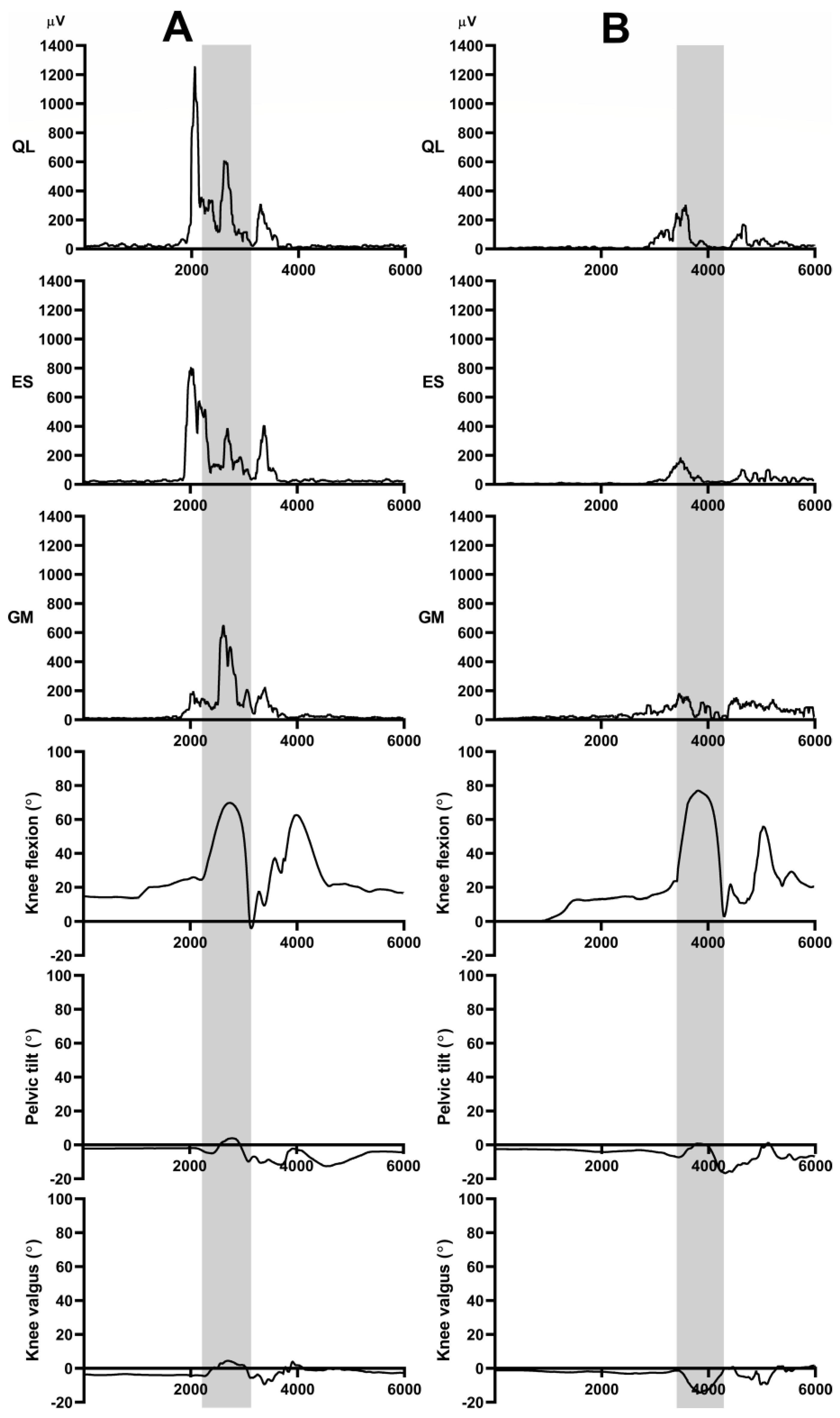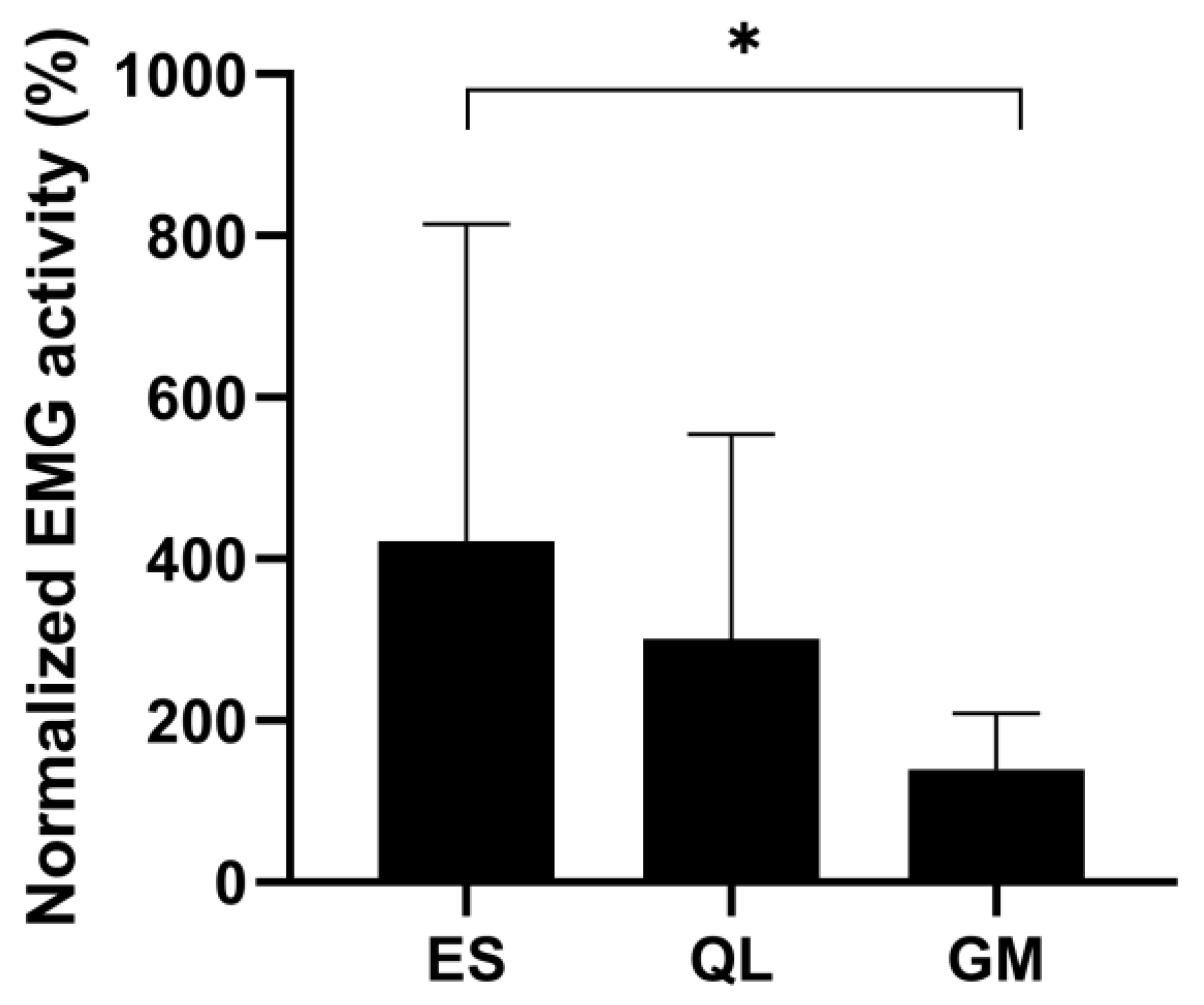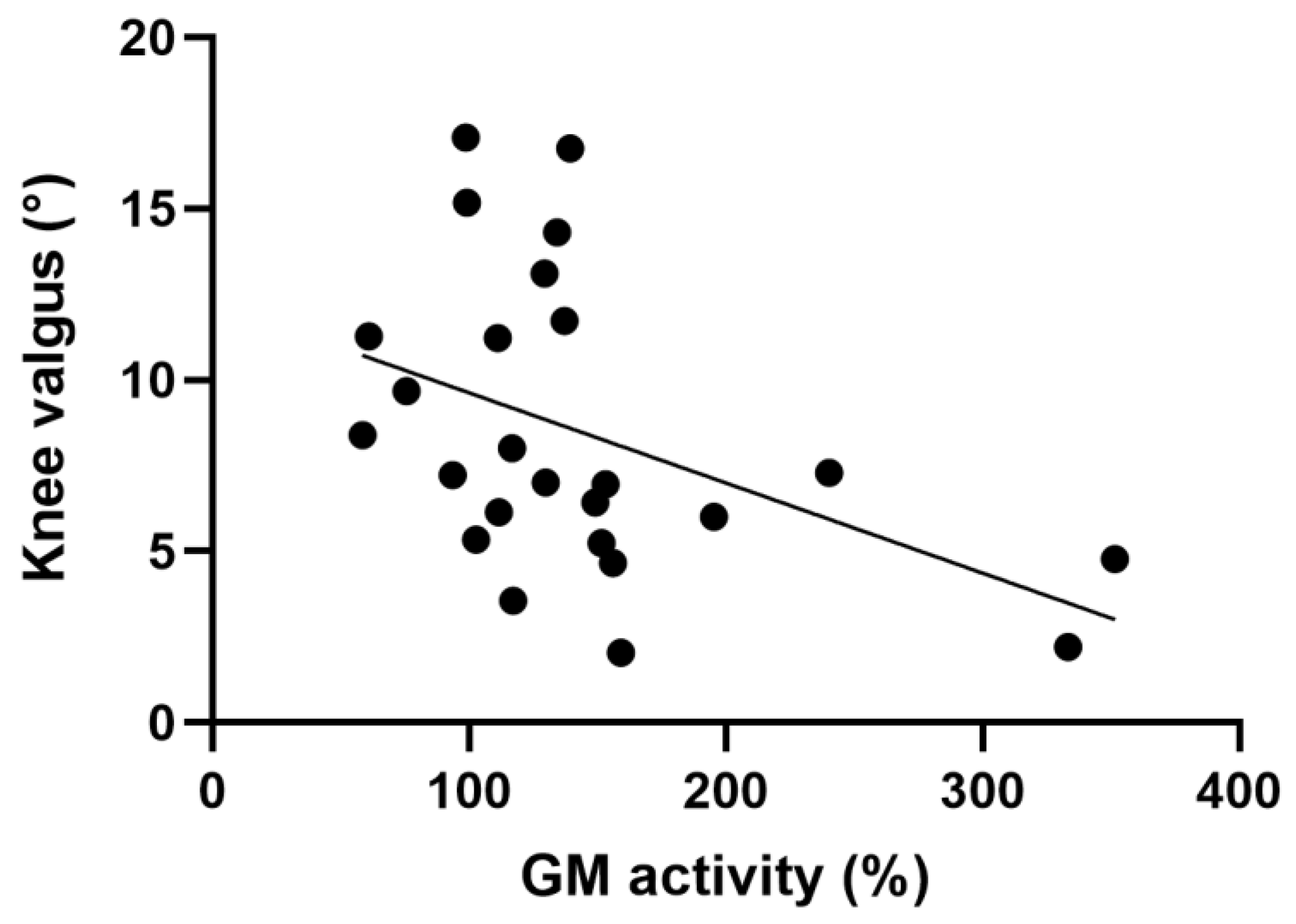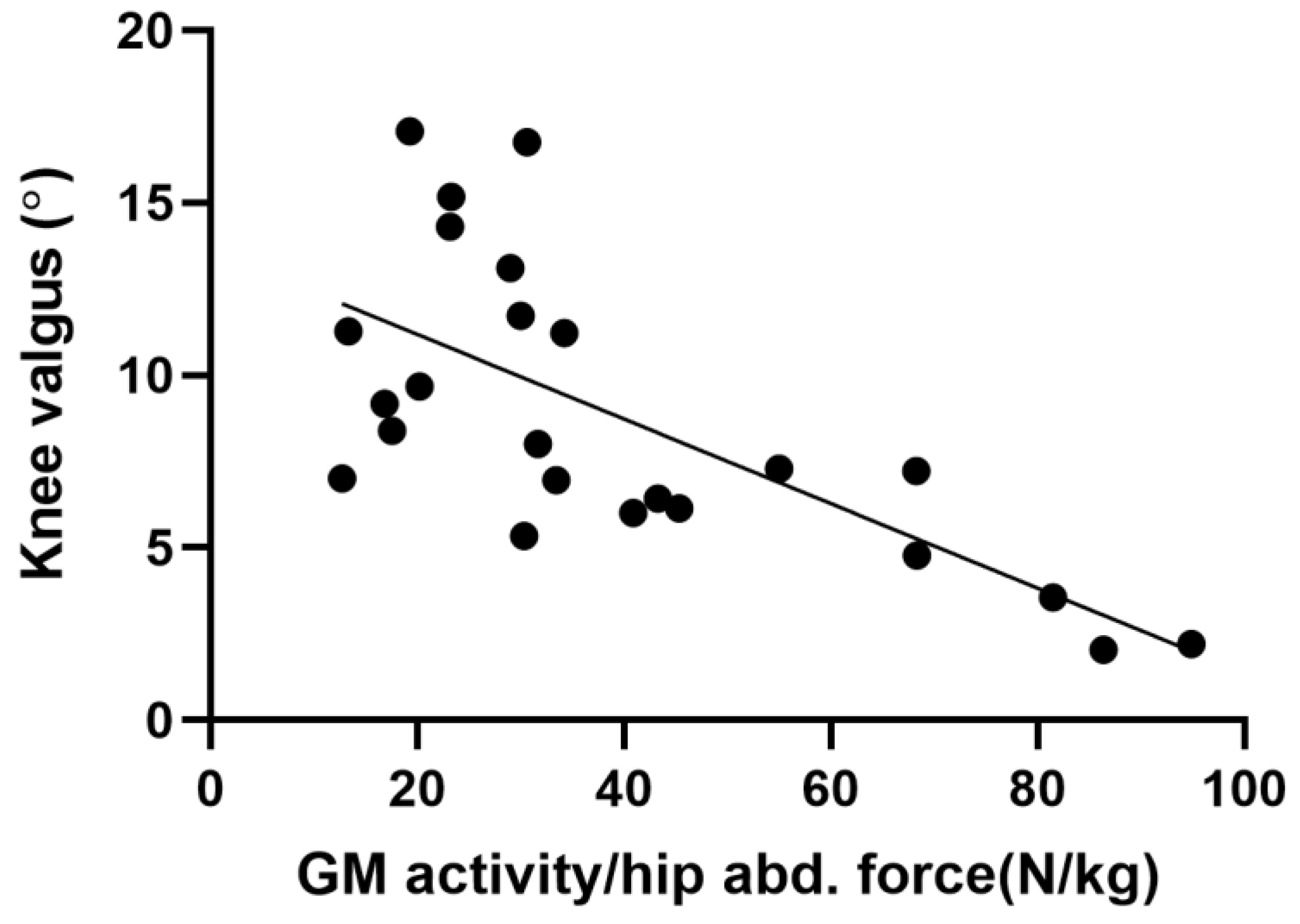Frontal Plane Neurokinematic Mechanisms Stabilizing the Knee and the Pelvis during Unilateral Countermovement Jump in Young Trained Males
Abstract
1. Introduction
2. Materials and Methods
2.1. Participants
2.2. Experimental Protocol
2.3. MVC Testing
2.4. UL-CMJ Testing
2.5. Surface EMG
2.6. Kinematic Analyses
2.7. Data and Statistical Analyses
3. Results
4. Discussion
5. Conclusions
Author Contributions
Funding
Institutional Review Board Statement
Informed Consent Statement
Data Availability Statement
Acknowledgments
Conflicts of Interest
References
- Cleather, D.J.; Goodwin, J.E.; Bull, A.M. Hip and knee joint loading during vertical jumping and push jerking. Clin. Biomech. 2013, 28, 98–103. [Google Scholar] [CrossRef] [PubMed]
- Perttunen, J.; Kyrolainen, H.; Komi, P.V.; Heinonen, A. Biomechanical loading in the triple jump. J. Sports Sci. 2000, 18, 363–370. [Google Scholar] [CrossRef] [PubMed]
- Jensen, R.; Ebben, W.P. Quantifying Plyometric Intensity Via Rate of Force Development, Knee Joint, and Ground Reaction Forces. J. Strength Cond. Res. Res. J. NSCA 2007, 21, 763–767. [Google Scholar]
- Tai, W.-H.; Wang, L.-I.; Peng, H.-T. Biomechanical Comparisons of One-Legged and Two-Legged Running Vertical Jumps. J. Hum. Kinet. 2018, 64, 71–76. [Google Scholar] [CrossRef] [PubMed]
- Impellizzeri, F.M.; Rampinini, E.; Maffiuletti, N.; Marcora, S.M. A Vertical Jump Force Test for Assessing Bilateral Strength Asymmetry in Athletes. Med. Sci. Sports Exerc. 2007, 39, 2044–2050. [Google Scholar] [CrossRef]
- Zazulak, B.T.; Ponce, P.L.; Straub, S.J.; Medvecky, M.J.; Avedisian, L.; Hewett, T.E. Gender Comparison of Hip Muscle Activity During Single-Leg Landing. J. Orthop. Sports Phys. Ther. 2005, 35, 292–299. [Google Scholar] [CrossRef]
- Phillips, S.; Mercer, S.; Bogduk, N. Anatomy and biomechanics of quadratus lumborum. Proc. Inst. Mech. Eng. Part H J. Eng. Med. 2008, 222, 151–159. [Google Scholar] [CrossRef]
- Willson, J.D.; Dougherty, C.P.; Ireland, M.L.; Davis, I.M. Core Stability and Its Relationship to Lower Extremity Function and Injury. J. Am. Acad. Orthop. Surg. 2005, 13, 316–325. [Google Scholar] [CrossRef]
- Czasche, M.B.; Goodwin, J.E.; Bull, A.M.J.; Cleather, D.J. Effects of an 8-week strength training intervention on tibiofemoral joint loading during landing: A cohort study. BMJ Open Sport Exerc. Med. 2018, 4, e000273. [Google Scholar] [CrossRef]
- de Permentier, P. Quadratus lumborum: Anatomy, physiology and involvement in back pain. J. Aust. Tradit.-Al-Med. Soc. 2015, 21, 241–242. [Google Scholar] [CrossRef]
- Kim, D.; Unger, J.; Lanovaz, J.L.; Oates, A.R. The Relationship of Anticipatory Gluteus Medius Activity to Pelvic and Knee Stability in the Transition to Single-Leg Stance. PM&R 2016, 8, 138–144. [Google Scholar] [CrossRef]
- Claiborne, T.L.; Armstrong, C.W.; Gandhi, V.; Pincivero, D.M. Relationship between Hip and Knee Strength and Knee Valgus during a Single Leg Squat. J. Appl. Biomech. 2006, 22, 41–50. [Google Scholar] [CrossRef]
- van Melick, N.; Meddeler, B.M.; Hoogeboom, T.J.; Nijhuis-van der Sanden, M.W.G.; van Cingel, R.E.H. How to determine leg dominance: The agreement between self-reported and observed performance in healthy adults. PLoS ONE 2017, 12, e0189876. [Google Scholar] [CrossRef]
- Monteiro, R.L.; Facchini, J.H.; De Freitas, D.G.; Callegari, B.; João, S.M.A. Hip Rotations’ Influence of Electromyographic Activity of Gluteus Medius Muscle During Pelvic-Drop Exercise. J. Sport Rehabil. 2017, 26, 65–71. [Google Scholar] [CrossRef]
- Dejnabadi, H.; Jolles, B.; Casanova, E.; Fua, P.; Aminian, K. Estimation and Visualization of Sagittal Kinematics of Lower Limbs Orientation Using Body-Fixed Sensors. IEEE Trans. Biomed. Eng. 2006, 53, 1385–1393. [Google Scholar] [CrossRef]
- Koo, T.K.; Li, M.Y. A Guideline of Selecting and Reporting Intraclass Correlation Coefficients for Reliability Research. J. Chiropr. Med. 2016, 15, 155–163. [Google Scholar] [CrossRef]
- Ueno, R.; Navacchia, A.; DiCesare, C.A.; Ford, K.R.; Myer, G.D.; Ishida, T.; Tohyama, H.; Hewett, T.E. Knee abduction moment is predicted by lower gluteus medius force and larger vertical and lateral ground reaction forces during drop vertical jump in female athletes. J. Biomech. 2020, 103, 109669. [Google Scholar] [CrossRef]
- Neamatallah, Z.; Herrington, L.; Jones, R. An investigation into the role of gluteal muscle strength and EMG activity in controlling HIP and knee motion during landing tasks. Phys. Ther. Sport 2020, 43, 230–235. [Google Scholar] [CrossRef]
- Nejishima, M.; Urabe, Y.; Yokoyama, S. Relationship between the Knee Valgus Angle and Emg Activity of the Lower Extremity in Single- and Double-Leg Landing. J. Biomech. 2007, 40, S743. [Google Scholar] [CrossRef]
- Herrington, L.; Munro, A. Drop jump landing knee valgus angle; normative data in a physically active population. Phys. Ther. Sport 2010, 11, 56–59. [Google Scholar] [CrossRef]
- Myer, G.D.; Ford, K.R.; Di Stasi, S.L.; Foss, K.D.B.; Micheli, L.J.; Hewett, T.E. High knee abduction moments are common risk factors for patellofemoral pain (PFP) and anterior cruciate ligament (ACL) injury in girls: Is PFP itself a predictor for subsequent ACL injury? Br. J. Sports Med. 2015, 49, 118–122. [Google Scholar] [CrossRef] [PubMed]
- Bordoni, B.; Varacallo, M. Anatomy, Abdomen and Pelvis, Quadratus Lumborum. In StatPearls; StatPearls Publishing: Treasure Island, FL, USA, 2022. Available online: http://www.ncbi.nlm.nih.gov/books/NBK535407/ (accessed on 19 May 2022).
- Shah, A.; Bordoni, B. Anatomy, Bony Pelvis and Lower Limb, Gluteus Medius Muscle. In StatPearls; StatPearls Publishing: Treasure Island, FL, USA, 2022. Available online: http://www.ncbi.nlm.nih.gov/books/NBK557509/ (accessed on 18 May 2022).
- Hides, J.A.; Stanton, W.R. Predicting football injuries using size and ratio of the multifidus and quadratus lumborum muscles. Scand. J. Med. Sci. Sports 2017, 27, 440–447. [Google Scholar] [CrossRef] [PubMed]
- dos Reis, A.C.; Correa, J.C.F.; Bley, A.S.; Rabelo, N.D.D.A.; Fukuda, T.Y.; Lucareli, P.R.G. Kinematic and Kinetic Analysis of the Single-Leg Triple Hop Test in Women With and Without Patellofemoral Pain. J. Orthop. Sports Phys. Ther. 2015, 45, 799–807. [Google Scholar] [CrossRef] [PubMed]
- Kotsifaki, A.; Van Rossom, S.; Whiteley, R.; Korakakis, V.; Bahr, R.; Sideris, V.; Jonkers, I. Single leg vertical jump performance identifies knee function deficits at return to sport after ACL reconstruction in male athletes. Br. J. Sports Med. 2022, 56, 490–498. [Google Scholar] [CrossRef] [PubMed]
- Oliver, G.D.; Keeley, D.W. Gluteal Muscle Group Activation and its Relationship With Pelvis and Torso Kinematics in High-School Baseball Pitchers. J. Strength Cond. Res. 2010, 24, 3015–3022. [Google Scholar] [CrossRef]
- Lanza, M.B.; Rock, K.; Marchese, V.; Addison, O.; Gray, V.L. Hip Abductor and Adductor Rate of Torque Development and Muscle Activation, but Not Muscle Size, Are Associated With Functional Performance. Front. Physiol. 2021, 12, 744153. [Google Scholar] [CrossRef]
- Sebesi, B.; Fésüs, Á.; Varga, M.; Atlasz, T.; Vadász, K.; Mayer, P.; Vass, L.; Meszler, B.; Balázs, B.; Váczi, M. The Indirect Role of Gluteus Medius Muscle in Knee Joint Stability during Unilateral Vertical Jump and Landing on Unstable Surface in Young Trained Males. Appl. Sci. 2021, 11, 7421. [Google Scholar] [CrossRef]
- Andersson, E.; Oddsson, L.; Grundström, H.; Nilsson, J.; Thorstensson, A. EMG activities of the quadratus lumborum and erector spinae muscles during flexion-relaxation and other motor tasks. Clin. Biomech. 1996, 11, 392–400. [Google Scholar] [CrossRef]
- Blache, Y.; Monteil, K. Influence of lumbar spine extension on vertical jump height during maximal squat jumping. J. Sports Sci. 2014, 32, 642–651. [Google Scholar] [CrossRef]
- Mills, J.D.; Taunton, J.E.; Mills, W.A. The effect of a 10-week training regimen on lumbo-pelvic stability and athletic performance in female athletes: A randomized-controlled trial. Phys. Ther. Sport 2005, 6, 60–66. [Google Scholar] [CrossRef]
- Ford, K.R.; Myer, G.D.; Hewett, T.E. Valgus Knee Motion during Landing in High School Female and Male Basketball Players. Med. Sci. Sports Exerc. 2003, 35, 1745–1750. [Google Scholar] [CrossRef] [PubMed]
- Kernozek, T.W.; Torry, M.R.; Van Hoof, H.; Cowley, H.; Tanner, S. Gender differences in frontal and sagittal plane biomechanics during drop landings. Med. Sci. Sports Exerc. 2005, 37, 1003. [Google Scholar] [PubMed]
- Ho, K.-Y.; Murata, A. Asymmetries in Dynamic Valgus Index After Anterior Cruciate Ligament Reconstruction: A Proof-of-Concept Study. Int. J. Environ. Res. Public Health 2021, 18, 7047. [Google Scholar] [CrossRef] [PubMed]






| Measured Variables | UL-CMJ ICC | MVC ICC |
|---|---|---|
| EMG ES | 0.460 | 0.965 |
| EGM QL | 0.816 | 0.735 |
| EMG GM | 0.608 | 0.836 |
| Knee valgus | 0.976 | |
| Pelvic tilt | 0.869 | |
| Propulsive impulse | 0.986 |
| I | KV | PT | Fabd | GM/Fabd | GM | ES | |
|---|---|---|---|---|---|---|---|
| KV | 0.01 | ||||||
| PT | 0.10 | 0.31 | |||||
| Fabd | 0.16 | 0.46 | −0.33 | ||||
| GM/Fabd | −0.07 | −0.56 * | −0.23 | −0.17 | |||
| GM | 0.13 | −0.45 * | −0.10 | 0.10 | 0.85 | ||
| ES | 0.43 * | −0.25 | −0.13 | −0.04 | 0.36 | 0.45 * | |
| QL | 0.42 * | 0.00 | −0.13 | 0.12 | −0.14 | 0.11 | 0.46 * |
Disclaimer/Publisher’s Note: The statements, opinions and data contained in all publications are solely those of the individual author(s) and contributor(s) and not of MDPI and/or the editor(s). MDPI and/or the editor(s) disclaim responsibility for any injury to people or property resulting from any ideas, methods, instructions or products referred to in the content. |
© 2022 by the authors. Licensee MDPI, Basel, Switzerland. This article is an open access article distributed under the terms and conditions of the Creative Commons Attribution (CC BY) license (https://creativecommons.org/licenses/by/4.0/).
Share and Cite
Vadász, K.; Varga, M.; Sebesi, B.; Hortobágyi, T.; Murlasits, Z.; Atlasz, T.; Fésüs, Á.; Váczi, M. Frontal Plane Neurokinematic Mechanisms Stabilizing the Knee and the Pelvis during Unilateral Countermovement Jump in Young Trained Males. Int. J. Environ. Res. Public Health 2023, 20, 220. https://doi.org/10.3390/ijerph20010220
Vadász K, Varga M, Sebesi B, Hortobágyi T, Murlasits Z, Atlasz T, Fésüs Á, Váczi M. Frontal Plane Neurokinematic Mechanisms Stabilizing the Knee and the Pelvis during Unilateral Countermovement Jump in Young Trained Males. International Journal of Environmental Research and Public Health. 2023; 20(1):220. https://doi.org/10.3390/ijerph20010220
Chicago/Turabian StyleVadász, Kitty, Mátyás Varga, Balázs Sebesi, Tibor Hortobágyi, Zsolt Murlasits, Tamás Atlasz, Ádám Fésüs, and Márk Váczi. 2023. "Frontal Plane Neurokinematic Mechanisms Stabilizing the Knee and the Pelvis during Unilateral Countermovement Jump in Young Trained Males" International Journal of Environmental Research and Public Health 20, no. 1: 220. https://doi.org/10.3390/ijerph20010220
APA StyleVadász, K., Varga, M., Sebesi, B., Hortobágyi, T., Murlasits, Z., Atlasz, T., Fésüs, Á., & Váczi, M. (2023). Frontal Plane Neurokinematic Mechanisms Stabilizing the Knee and the Pelvis during Unilateral Countermovement Jump in Young Trained Males. International Journal of Environmental Research and Public Health, 20(1), 220. https://doi.org/10.3390/ijerph20010220







